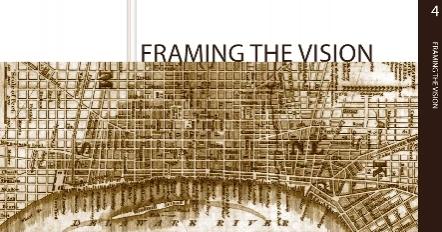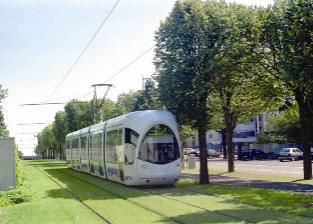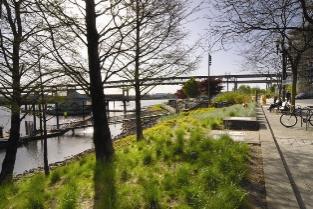Stuart Weitzman School of Design
102 Meyerson Hall
210 South 34th Street
Philadelphia, PA 19104
Get the latest Weitzman news in your Inbox
A Civic Vision For the Central Delaware: Framing the Vision
In 1683, William Penn and Thomas Holme created a plan to guide Philadelphia’s growth. The plan was sensible and refl ected the fact that Philadelphia began partly as a business venture. First, their plan established a gridiron street network that facilitated connectivity and commerce; second, in a manner evocative of the European trend toward the “greene country towne,” the plan established a series of public squares; and third, the plan allowed for the subdivision of land, which set the stage for residential, commercial and industrial development. For the past 325 years, Penn and Holme’s fl exible framework for building a community has served Philadelphia well, successfully guiding the city’s growth and allowing for an easy mix of uses between businesses and residences.
Yet today, because much of the central Delaware riverfront lacks this formative framework, riverfront development is occurring in a haphazard fashion. A Civic Vision for the Central Delaware seeks to inspire Philadelphia’s citizens to aspire toward a higher-quality built environment. The plan presents the citizens of Philadelphia with a challenge: to transform the physical and regulatory landscape of the central Delaware at a critical juncture in the city’s history. The plan seeks to enable developers, political leaders and citizens to establish the framework for a legacy of urban excellence for generations to come. A Civic Vision for the Central Delaware combines William Penn and Thomas Holme’s timeless lessons with the aspirations of Philadelphia’s residents to envision Philadelphia as a fresh, modern, premier riverfront city. The strength of this civic vision lies in the fact that its values and principles are citizen derived. As such, they reflect what is meaningful to Philadelphia—what matters about its past as well as what is valuable in its present and desired for its future.
Framing the Vision (pdf)

A Civic Vision for the Central Delaware offers a comprehensive vision that translates citizen-driven values and principles into an integrated series of networks—networks that can create, support and sustain the civic vision for the central Delaware for generations to come. The three networks described in this vision—movement systems, parks and open space, and land development— represent both the planning principles outlined earlier and best planning practices. These principles and practices include ideas about urban growth and densities, ecological sustainability and effective transportation policies.
Below we offer an overview of the three networks, including the goals and recommendations formed during our extensive process of soliciting and integrating citizen voices and the input of local and international experts.

Movement Systems
In order to extend Philadelphia to the river’s edge, we will need to create new movement systems that will work together to serve as a template for riverfront growth. New streets will determine the size of development parcels and optimize public riverfront access; they will incorporate public transit for residents and tourists, a recreational trail and a right-of-way dedicated to biking. These movement systems will improve connectivity by increasing route options for all modes of transportation and shifting the focus of the central Delaware from the car to the pedestrian, cyclist and jogger.
Goal: To increase opportunities for public access to the riverfront and to help shape urban development through infrastructure investment and transportation policies that lessen auto congestion in the project area. Increasing public access and improving transportation options are goals that directly express the concerns shared by thousands of Philadelphia citizens at public forums. These concerns include inadequate public access to the riverfront, the domination of the riverfront landscape by automobiles and a scarcity of transportation connections along the central Delaware.

Parks and Open Space
What makes a riverfront an asset to any city? The celebrated riverfronts of the world are defined by their park spaces, which function as links between major destinations within their cities. These public green spaces at the river’s edge improve the health not only of nearby neighborhoods, but also of the city and its surrounding region.
Goals: To improve riverfront life and promote water quality by building a network of attractive, public open spaces. This sustainable system should serve local residents while increasing the area’s economic and ecological viability. The goals of improving the quality of life along the river and the quality of the river itself are responses to concerns that surfaced during the public forums. These concerns include a lack of safe public space along the riverfront, threatened river habitats and inadequate opportunities for river recreation, including boat-related activities.

Land Development
Celebrated urban riverfronts offer many types of activities to their visitors; they are not single-use destinations. Thus A Civic Vision for the Central Delaware does not outline a parcel-by-parcel program of land use; instead, it supplies a blueprint for development that, if followed, will turn the central Delaware into a vital extension of the vibrant urban life that already exists to the west of I-95.
Goal: To extend Philadelphia’s urban neighborhoods to the river’s edge in a way that is mixed-use, transit-oriented and supportive of changing market conditions. As with the previous two network categories, this goal directly reflects the concerns expressed by citizens at public forums. Their concerns include the following: the ad hoc state of development approvals along the riverfront, the increase in non-waterfront-dependent uses along the river’s edge and the apparent lack of concern for both social equity and sustainable design in development proposals.
The following chapters explore the three networks in greater detail and provide research and recommendations to guide Philadelphia toward the creation of an active, vibrant riverfront—a memorable place that will honor and serve the city for generations to come.
